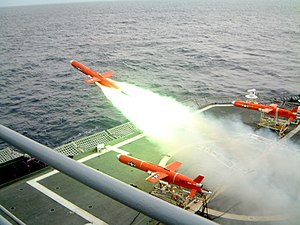BQM-74 Chukar
| BQM-74 Chukar | |
|---|---|
 |
|
| Role | Unmanned Aerial Vehicle |
| Manufacturer | Northrop |
| First flight | 1965 |
| Introduction | 1968, U.S. Navy |
| Unit cost |
$405,000
|
The BQM-74 Chukar is a series of aerial target drones produced by Northrop. The Chukar has gone through three major revisions, including the initial MQM-74A Chukar I, the MQM-74C Chukar II, and the BQM-74C Chukar III. They are recoverable, remote controlled, subsonic aerial target, capable of speeds up to Mach 0.86 and altitudes from 30 to 40,000 ft (10 to 12,000 m).
The BQM-74E is propelled during flight by a single Williams J400 (J400-WR-404) turbojet engine, which produces a maximum thrust of 240 pounds force (1068 N) at sea level. The BQM-74 is launched from a zero length ground launcher utilizing dual Jet Assisted Takeoff (JATO) bottles. When equipped with an air launch kit, the BQM-74 can be air launched from a TA-4J, F-16, Grumman Gulfstream I or DC-130 aircraft. The BQM-74 is used primarily as a realistic aerial target, capable of simulating enemy threats for gunnery and missile training exercises.
Drones are capable of being recovered following a training exercise. A parachute is deployed by remote control or if the remote control link is severed and a flotation kit can be added for sea-based recovery. If recovery of the drone is required, special telemetry warheads are used on the defensive missile in place of explosives. This telemetry warhead is desirable since it allows for extensive analysis of the performance of the defensive missile, including miss distance information that determines if a real warhead would have damaged the target. A direct hit would likely destroy the drone. Gunnery systems would use non-explosive dummy munitions. Since gunnery systems are aimed in front of a moving target so it will fly through the blast-fragments, dummy munitions do not have to directly hit a target. Analysis of radar data would determine if actual explosive munitions would have damaged the target drone.
The Chukar series began in the early 1960s with a US Navy requirement for a new target drone. The company developed a prototype with the company designation of NV-105 and featuring a delta wing, flying it in 1964. The delta wing didn't work out and was replaced by a straight wing, resulting in the NV-105A, which was first flown in 1965. The NV-105A was accepted by the Navy and went into production as the MQM-74A in 1968.
...
Wikipedia
